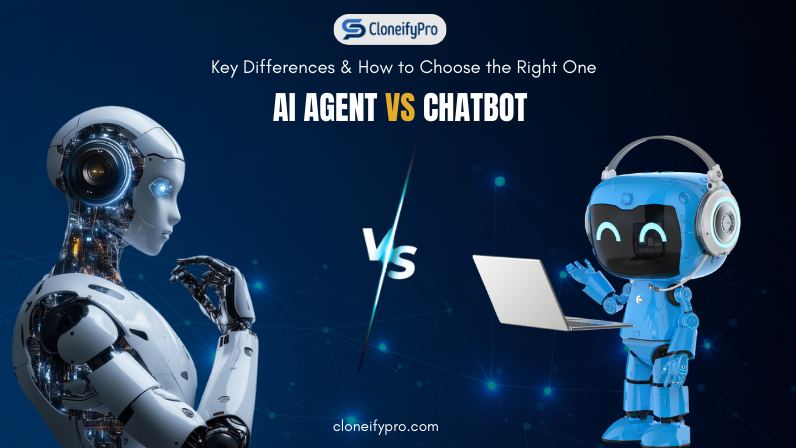Technology
AI Agents VS AI Chatbots – What are the Key Differences

Today, the term ‘chatbot’ is typically used to refer to simple automated bots, while the term ‘AI agent’ can be used to describe the role AI can perform previously performed by humans. AI technology has advanced from the technology that powered chatbots in the past, with massive, customized language models currently forming the core of the technology.
Additionally, AI agents can handle various tasks and provide personalized assistance. This makes them much more versatile and efficient than predecessors and allows them to offer a more personalized user experience.
It’s common to mix AI agents and chatbots. Although both can communicate, AI agents open up an array of possibilities that chatbots traditionally cannot.
What is a Chatbot?
Chatbots are programs designed to mimic a conversation with a person via various channels. In recent years, their use has increased within companies due to the fact that they help manage customer demand across different channels. However, to overcome their limitations, businesses often turn to AI agent development services to create more advanced and efficient conversational solutions.
Rule-Based
They use a predefined script, also known as a “decision tree.” They use a framework created by a human being, which isn’t always able to provide all the possible scenarios in a real-life conversation.
Generate Frustration
Users realize that they’re interacting with a bot. However, because of the limitations described, most bots need help knowing what they need. This can result in an unpleasant experience.
Difficulty Extracting Insights
Because humans aren’t able to fully comprehend the meaning of conversations, it’s difficult for them to gain useful information. This is why humans need to examine the conversations to discover patterns or commonalities.
This can lead to poor user experience and hinder the work of those responsible for optimizing and supervising the systems.
What is an AI Agent?
The term “AI agent” refers to software capable of communicating with its environment, collecting data, and employing it to meet specific objectives. As compared to chatbots, AI agents possess these characteristics:
Goal-Oriented
Humans determine the goals, and the agent communicates with the surroundings to collect information and perform tasks to accomplish those goals.
Versatile Interaction
They can communicate using text, voice, or video—they aren’t restricted to just a chat. In addition, they can connect with various APIs to carry out more complicated workflows.
Natural Conversation
Through a realistic simulation of human conversations, they can relive conversations to avoid frustrations. They keep the conversation’s context to give clear responses.
Thinking Units
They may function as part of a larger system where several agents interact with one another. This allows the breakdown of complicated tasks into smaller tasks that each agent can manage effectively.
Learning Capability
They can learn from the company’s data or read PDFs, databases, and other relevant sources that can help them achieve their objectives.
Provision of Insights
An agent who collects insights can analyze chatbot conversations, rewrite them, and draw useful data.
Major Difference Between AI Chatbots and AI Agents
AI chatbots, as well as AI agents, use artificial intelligence to help people and businesses. They’re designed to recognize how we speak or type and respond to that input. They’re digital assistants who are always available to help – whether they’re answering questions, tackling issues, or getting things accomplished.
AI chatbots and AI agents are frequently confused because of their common basis in artificial intelligence and their capability to communicate with users using natural conversation. The difference between them could be difficult to discern, particularly as chatbots grow more sophisticated and agents become interactive, causing many to refer to them in a way that is compatible with their different capabilities and purposes of design.
Capabilities for Task Completion
AI chatbots were designed to perform specific, limited tasks. They are excellent at answering simple questions, leading users through predetermined processes, or handling basic transactions. However, their abilities run into a snag when faced with multi-step or complex tasks (or any other task beyond their narrow programming).
AI agents can tackle complex, multi-stage procedures that cover a variety of technologies and applications. For example: Are you planning your next trip? An AI agent can look up destinations, check flight prices, book hotels, and suggest activities from one command.
Scope of Knowledge
Most chatbots operate within a narrow knowledge domain typically targeted at a particular product or service. Their database is typically restricted to the information they provide during training sessions or by regular updates. For instance, a car dealership may have a chatbot running on their website, which can answer various questions specific to their vehicle models and makes, such as prices, specifications, and availability. Although some chatbots can connect to external databases or APIs, they can independently combine information from various sources or expand their knowledge.
On the other hand, AI agents typically have greater information. They can leverage language models, real-time data streams, and various external sources to collect and process data instantaneously. AI Agents can think across domains, draw logic-based inferences, and develop fresh knowledge by combining information in new ways. The vast knowledge base they have built allows agents to tackle a greater variety of tasks and queries with greater flexibility and precision.
Interaction Complexity
AI chatbots usually handle simple conversational text with a set of parameters. They excel in answering typical questions, leading users through simple procedures, and providing relevant details from a well-structured knowledge base. Chatbots typically use pattern matching or basic language processing to understand user inputs and select the appropriate responses from a pre-programmed set of choices.
AI agents, however, engage in more complicated multi-step interactions that could involve multiple platforms or services. They can understand complex directions, reduce complicated tasks into simpler steps, and execute the actions. Advanced AI agents employ advanced natural language processing, context awareness, and decision-making algorithms to manage ambiguous requests and then adapt their strategy based on the latest feedback and changes in circumstances.
Learning and Adaptation
Traditional chatbots typically depend on static decision tree models or pre-defined response patterns, which limit their capacity to change and adapt dynamically. Modern implementations can utilize machine learning algorithms to improve the selection of responses as time passes, but the learning process is generally restricted to a particular domain. Even with frequent updates, chatbots struggle to deal with new situations or queries that are not part of their training data.
Conversely, AI agents use continuous learning algorithms and adaptive models that adapt with every interaction. They can use the knowledge gained from previous experiences to apply it to new situations and adapt their strategies according to user feedback. Through transfer and reinforcement learning techniques, agents can increase their abilities across a range of areas of study, becoming more adaptable and efficient with application.
The Key Takeaway
While AI technology continues to develop, the number of AI agents is expected to increase dramatically. An AI development company can play a pivotal role in this evolution, ensuring that agent interactions become more intuitive through voice, text, and visual media. An enhanced understanding of context is crucial to allowing agents to provide more pertinent information as time passes.
Although the development of chatbots in the past was not as thrilling as that of AI agents, in the future we may see tangible improvements regarding user experiences, better integration with other business systems, and the ease of implementing custom chatbot flows and responses.
As we collectively navigate the ever-changing AI environment, chatbots and agents can help your business now and in the future to maximize their effectiveness.
-

 Celebrity5 months ago
Celebrity5 months agoTrey Kulley Majors: The Untold Story of Lee Majors’ Son
-

 Celebrity5 months ago
Celebrity5 months agoChristina Erika Carandini Lee: A Life of Grace, Heritage, and Privacy
-

 Celebrity5 months ago
Celebrity5 months agoJamie White-Welling: Bio, Career, and Hollywood Connection Life with Tom Welling
-

 Celebrity4 months ago
Celebrity4 months agoNick Schmit? The Man Behind Jonathan Capehart Success
















